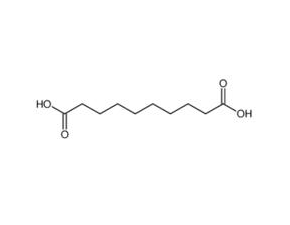
Sebacic acid
CAS No. 111-20-6
Sebacic acid( 1,10-Decanedioic acid | Acide sebacique | Sebacinsaure )
Catalog No. M17820 CAS No. 111-20-6
Dioxazine hydrochloride is a derivative of promethazine, which has strong H1 receptor blockade of histamine.
Purity : >98% (HPLC)
 COA
COA
 Datasheet
Datasheet
 HNMR
HNMR
 HPLC
HPLC
 MSDS
MSDS
 Handing Instructions
Handing Instructions
| Size | Price / USD | Stock | Quantity |
| 100MG | 38 | In Stock |


|
| 200MG | Get Quote | In Stock |


|
| 500MG | Get Quote | In Stock |


|
| 1G | Get Quote | In Stock |


|
Biological Information
-
Product NameSebacic acid
-
NoteResearch use only, not for human use.
-
Brief DescriptionDioxazine hydrochloride is a derivative of promethazine, which has strong H1 receptor blockade of histamine.
-
DescriptionDecanedioic acid aslo know as Sebacic acid. It is produced from castor oil by using sodium hydroxide, sulfuric acid with catalysts including zinc oxide and phenol.[citation needed] Byproducts include glycerol, octanol and polymer residue. Sebacic acid has been used in the synthesis of: biodegradable and elastomeric polyesters [poly(glycerol sebacate)], novel bio-nylon, PA5.10, novel temperature-response hydrogel based on poly(ether-ester anhydride) nanoparticle for drug-delivery applications.
-
In Vitro——
-
In Vivo——
-
Synonyms1,10-Decanedioic acid | Acide sebacique | Sebacinsaure
-
PathwayOthers
-
TargetOther Targets
-
RecptorHIV
-
Research AreaOthers-Field
-
Indication——
Chemical Information
-
CAS Number111-20-6
-
Formula Weight202.25
-
Molecular FormulaC10H18O4
-
Purity>98% (HPLC)
-
SolubilityIn Vitro:?DMSO : ≥ 100 mg/mL (494.44 mM)
-
SMILESC(CCCCC(=O)O)CCCC(=O)O
-
Chemical Namedecanedioic acid
Shipping & Storage Information
-
Storage(-20℃)
-
ShippingWith Ice Pack
-
Stability≥ 2 years
Reference
1.Clemente Bretti, et al. Eng. Data. 51 (5): 1660–1667.
molnova catalog



related products
-
Abafungin
Abafungin is an antifungal agent with a broad-spectrum.
-
CGP37157
CGP37157 is a Na+/Ca2+ exchanger inhibitor, inhibits Na+-induced Ca2+ release from mitochondria in guinea pig heart with IC50 of 0.8 μM.
-
Celosin I
Celosin H, celosin I, and celosin J could be used as chemical markers for the quality control of C. argentea seeds.



 Cart
Cart
 sales@molnova.com
sales@molnova.com


